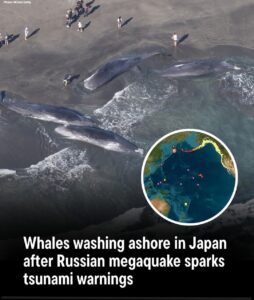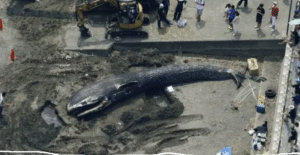Strange Whale Strandings in Japan Follow Major Russian Quake and Tsunami Alerts

On July 30, 2025, the earth shook violently beneath the sea near Russia’s Kamchatka Peninsula. The powerful 8.7 magnitude earthquake triggered tsunami warnings across the Pacific Rim, including along the coastlines of Japan. Although the resulting waves were relatively minor—rising to just 60 centimeters in areas like Hokkaido and Ibaraki—what happened next was far more alarming.
In Tateyama City, Chiba Prefecture, residents woke to a grim and baffling sight: multiple whales had washed ashore. Some were already dead; others lay struggling in the surf. The unsettling scene drew crowds, sparked media coverage, and mobilized marine scientists who scrambled to understand what could have driven such an event.
A Haunting Echo from the Past
Many in Japan were reminded of a similar occurrence in 2011. Just six days before the catastrophic Tōhoku earthquake and tsunami, about 50 dolphins were found stranded in Ibaraki Prefecture. That event, now eerily mirrored by the July 2025 whale stranding, has reignited debate over whether nature is once again reacting—or warning.
What Might Be Behind the Mass Beaching?
Although whale strandings aren’t uncommon, the timing of this one—so soon after a seismic event—has intensified speculation. Several theories have emerged from experts attempting to decode this unsettling mystery.

1. The Tsunami Suction Theory
When a tsunami forms, the sea often recedes dramatically before the wave comes ashore. This sudden drawdown of water can trap sea life close to shore.
“It’s similar to pulling the drain plug in a bathtub,” explained a marine scientist from the University of Tokyo. “Anything near the edge is vulnerable to being pulled in or left behind.”
2. Echolocation Confusion
Whales depend on sound to orient themselves. Their sophisticated echolocation systems allow them to navigate the deep. But an undersea earthquake can send shockwaves and pressure disturbances that may interfere with these systems, possibly leading disoriented whales into shallow waters.
3. Pod Loyalty Gone Awry
Whales are known for their social bonds. If a single whale becomes stranded, others in the pod might instinctively follow in an attempt to stay together—often resulting in multiple animals beaching themselves out of solidarity.
Are These Warnings from Nature?
In Japanese folklore, animal behavior is often interpreted as a form of divine or natural messaging. The recent mass stranding has rekindled ancient fears and philosophies about the natural world’s ability to signal upcoming disasters.
Though there’s no scientific consensus that whales can detect earthquakes before they occur, some marine biologists admit these events might not be pure coincidence. Environmental sensitivity in whales is well-documented, and behavioral anomalies could, in theory, precede seismic shifts.
Still, no definitive link has been proven. But the parallel between this incident and what occurred days before the 2011 tragedy has not gone unnoticed by the public.
Photo from the 2011 dolphin stranding in Ibaraki—widely believed by many to have foreshadowed the deadly Tōhoku earthquake – Image: NHK
Is Climate Change the Hidden Catalyst?
Earthquakes aren’t the only stressors altering marine life. Rising ocean temperatures, disrupted current patterns, and increasing noise pollution from human activity have all been cited as potential contributors to whale disorientation.
With their migration paths thrown off and traditional habitats becoming uninhabitable, whales may find themselves in unknown waters, sometimes too close to shore for safety.
Japan is not alone. Similar mass strandings have occurred in recent years across New Zealand and Australia, signaling that a global environmental shift may be impacting these majestic creatures.
Marine specialists stress that blue whale strandings, in particular, are exceedingly rare, suggesting that the cause is likely multifaceted.
Nature’s Message—or a Cry for Help?
The heartbreaking image of beached blue whales stretching along Japan’s coast has left a deep emotional and symbolic impression. For some, it is nature’s way of speaking—calling attention to the fragile systems we’ve pushed to their limits. For others, it’s a scientific puzzle that needs solving.
Whether seen as an omen or a warning, one truth emerges from the wreckage: humanity’s relationship with the planet is delicate—and deeply interconnected.
Perhaps it’s time we truly listened to the ocean before its warnings grow louder and more irreversible.